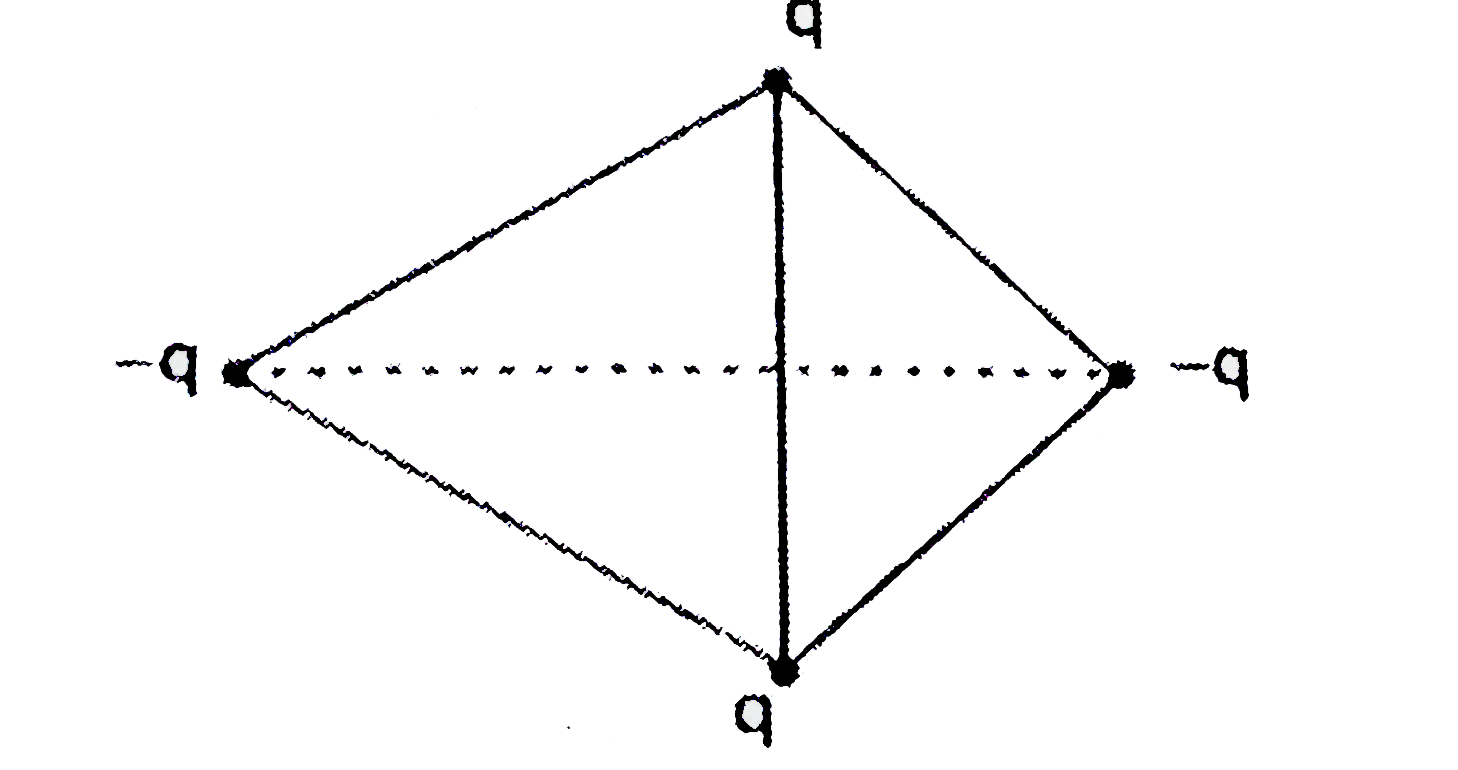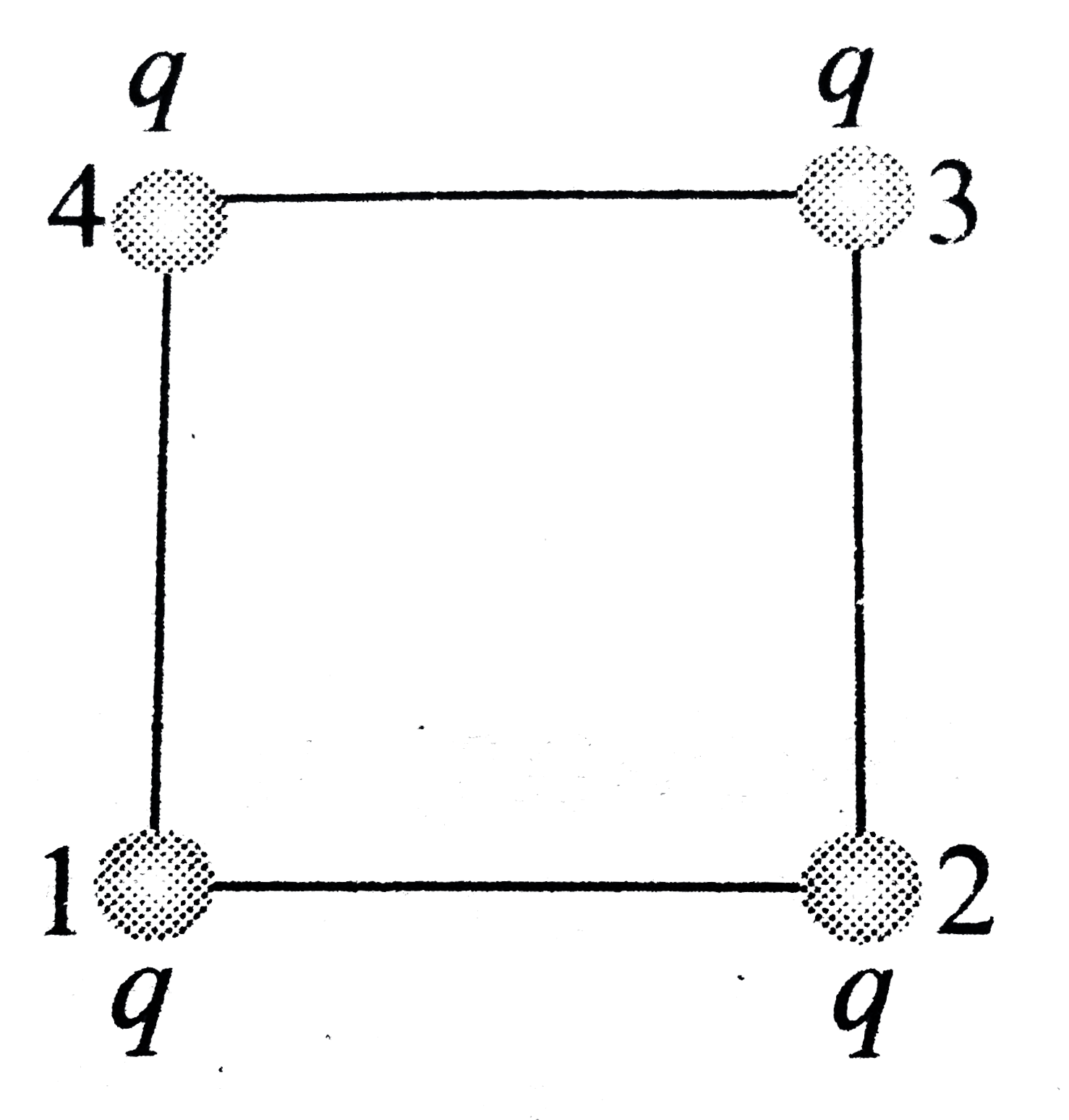Four equal charges of magnitudes q each are placed at four corners of a square with its centre at origin and lying in y-z plane. Aa fifth charge +Q is moved along x-axis. The electrostatic potential energy (U) varies on x-axis as




The correct Answer is:B
To solve the problem, we need to analyze the electrostatic potential energy (U) of a charge +Q placed along the x-axis due to four equal charges q located at the corners of a square in the y-z plane. Let's break down the solution step by step.
Step 1: Understand the Configuration
We have four charges q placed at the corners of a square with side length a. The center of the square is at the origin (0, 0, 0), and the square lies in the y-z plane. The coordinates of the charges can be defined as:
- Charge 1: (0,a2,a2)
- Charge 2: (0,a2,−a2)
- Charge 3: (0,−a2,a2)
- Charge 4: (0,−a2,−a2)
The charge +Q is moved along the x-axis at a distance x from the origin.
Step 2: Calculate the Distance from Charge +Q to Each Charge q
The distance r from the charge +Q at position (x,0,0) to any charge q at position (0,y,z) can be calculated using the Pythagorean theorem:
r=√x2+(a2)2+(a2)2=√x2+a22
Step 3: Calculate the Total Potential Energy
The potential energy U due to one charge q at distance r is given by:
Uq=kqQr
where k is Coulomb's constant.
Since there are four charges, the total potential energy U is:
U=4⋅kqQ√x2+a22
Step 4: Analyze the Variation of Potential Energy
From the expression for U:
U=4kqQ√x2+a22
we can see that as x increases, the denominator √x2+a22 increases, which means that U decreases.
Step 5: Determine the Behavior as x Approaches Infinity
As x approaches infinity:
U→0
This indicates that the potential energy approaches zero as the charge +Q moves far away from the square of charges.
Step 6: Find the Maximum Potential Energy
To find the maximum potential energy, we can differentiate U with respect to x and set the derivative to zero:
dUdx=0
Solving this will show that the maximum potential energy occurs at x=0.
Conclusion
The potential energy U decreases as x increases, and it is maximum when x=0. The potential energy approaches zero as x approaches infinity.
We have four charges q placed at the corners of a square with side length a. The center of the square is at the origin (0, 0, 0), and the square lies in the y-z plane. The coordinates of the charges can be defined as:
- Charge 1: (0,a2,a2)
- Charge 2: (0,a2,−a2)
- Charge 3: (0,−a2,a2)
- Charge 4: (0,−a2,−a2)
The distance r from the charge +Q at position (x,0,0) to any charge q at position (0,y,z) can be calculated using the Pythagorean theorem:
r=√x2+(a2)2+(a2)2=√x2+a22
The potential energy U due to one charge q at distance r is given by:
Uq=kqQr
where k is Coulomb's constant.
U=4⋅kqQ√x2+a22
From the expression for U:
U=4kqQ√x2+a22
we can see that as x increases, the denominator √x2+a22 increases, which means that U decreases.
As x approaches infinity:
U→0
This indicates that the potential energy approaches zero as the charge +Q moves far away from the square of charges.
To find the maximum potential energy, we can differentiate U with respect to x and set the derivative to zero:
dUdx=0
Solving this will show that the maximum potential energy occurs at x=0.
The potential energy U decreases as x increases, and it is maximum when x=0. The potential energy approaches zero as x approaches infinity.
Topper's Solved these Questions
- BOOK - DC PANDEY ENGLISHCHAPTER - ELECTROSTATICSEXERCISE - Comprehension36videos
ELECTROSTATICS
- BOOK - DC PANDEY ENGLISHCHAPTER - ELECTROSTATICSEXERCISE - Matrix Matching2videos
ELECTROSTATICS
- BOOK - DC PANDEY ENGLISHCHAPTER - ELECTROSTATICSEXERCISE - Integer17videos
ELECTROSTATICS
- BOOK - DC PANDEY ENGLISHCHAPTER - ELASTICITYEXERCISE - Medical entrances s gallery21videos
ELASTICITY
- BOOK - DC PANDEY ENGLISHCHAPTER - EXPERIMENTSEXERCISE - Subjective15videos
EXPERIMENTS
Similar Questions
Knowledge Check
- Question 1 - Select One
Four equal charges Q are placed at the four corners of a square of each side is 'a'. Work done in removing a charge −Q from its centre to infinity is
AzeroB√2q2πε0aC√2qπε0aDq2πε0a
Four small point charges (each of equal magnitude q) are placed at four corners of a regular tetrahedron of side a. find out potential energy of charge system
 View Solution
View SolutionFour identical point charges q are placed at four corners of a square of side a. Find the potential energy of the charge system.
 .View Solution
.View SolutionFour charges equal to −Q are placed at the four corners of a square and a charge q is at its centre. If the system is in equilibrium the value of q is
View SolutionFour charges of +q, +q +q and +q are placed at the corners A, B, C and D of s square. The resultant force on the charge at D
View SolutionFour charges of +q, +q +q and +q are placed at the corners A, B, C and D of s square. The resultant force on the charge at D
View SolutionFour point charges are placed at the corners of a square of side l. Calculate potential at the centre of square.
 View Solution
View SolutionFour identical charges each .q. are placed at four corners of a square of side .a.. Find the charge to be placed at the centre of the square so that the system of charges is in equilibrium
View Solution

